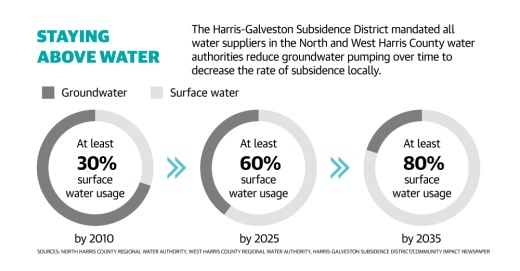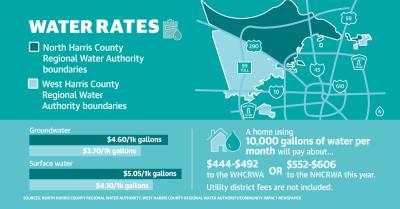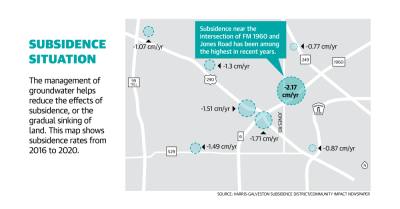This process has been ongoing since the 2000s as underground water sources begin to dry up and the state government sets out to reduce regional subsidence, or the gradual sinking of land.
“The bottom line is we had to do the conversion for 2010, 2025 and 2035 because of the subsidence issues,” NHCRWA President Al Rendl said. “But if you talk to most of the utility district operators and directors today, they will tell you that we’re converting because if we don’t, we run out of water in the aquifers, and so it’s a matter of being able to subsist into the future with plenty of potable water.”
Why surface water?
Officials with the West Harris County Regional Water Authority said as much as 7 feet of subsidence was measured in the northwest Harris County area between 1906 and 2000.
The Texas Legislature created the Harris-Galveston Subsidence District in 1975 to help stop subsidence by controlling the use of groundwater. Starting in 2003, the district mandated the NHCRWA, the WHCRWA and other entities reach at least 30%, 60% and 80% surface water reliance in 2010, 2025 and 2035, respectively.
To access groundwater historically, utility districts delivered water to Harris County residents outside the city of Houston through wells tapped into underground aquifers. According to water authority officials, potable water in the Gulf Coast Aquifer System is in short supply.
Both the NHCRWA and the WHCRWA are on track to reach the next deadline of a 60% reliance on surface water by 2025. Community Impact Newspaper previously reported the subsidence district will impose steep penalty fees on water authorities if this deadline is not met.
Construction began in early 2020 on the Surface Water Supply Project, a joint effort between the WHCRWA and the North Fort Bend Water Authority to distribute surface water and meet groundwater reduction requirements.
Officials said 47 of the 127 utility districts under the WHCRWA have been converted to surface water as of press time. Most of the Cy-Fair area neighborhoods located in the WHCRWA’s boundaries have already been converted to surface water.
Because it is more expensive to treat and deliver surface water, the water authorities charge utility districts more than they would for groundwater. Groundwater pumpage fees for the WHCRWA are $3.70 per 1,000 gallons, while the NHCRWA charges $4.60 per 1,000 gallons. Surface water fees for the respective authorities are $4.10 per 1,000 gallons and $5.05 per 1,000 gallons.
New infrastructure
Construction is underway on a new NHCRWA pump station on Gessner Road near Beltway 8. The project includes a new transmission line starting at West Lake Houston Parkway and Beltway 8, which will split into two pipes along Beltway 8 to I-45, Rendl said.
This project is expected to allow for additional water intake to reach utility districts farther west.
“It will have the ability to take the water from the purification plant on Lake Houston; it will be testing it constantly, adding chloramines as necessary and then pushing it out to the utility districts that will be part of the system as we go forward,” Rendl said.
Construction will be ongoing until about mid-2024. The pump station and additional piping to reach another 40-50 utility districts is about a $650 million project, according to Rendl.
Meanwhile, officials with the Surface Water Supply Project said the WHCRWA has begun construction on four of the project’s seven primary water line segments with plans to have the remaining water line segments and two pump stations under construction by 2023. One pump station will be at Fry and Clay roads, and the other will be at Fairbanks North Houston and West Little York roads, officials said.
“The costs of the regional projects necessary are estimated to exceed $5 billion, with the WHCRWA share estimated to be $1.6 billion,” WHCRWA board President Eric Hansen said.
Officials said funding for these projects will come from bonds sold to the TWDB through the State Water Implementation Revenue Fund for Texas, which are repaid through revenue from groundwater pumpage and surface water fees.
“What we are doing is ensuring that everyone has the potable water that’s necessary for life and that what we are doing not only provides water for the future, but it continues to provide for housing values to increase as demand for housing continues to grow,” Rendl said. “When you put a water rationing sign anywhere in the community, home prices drop.”







